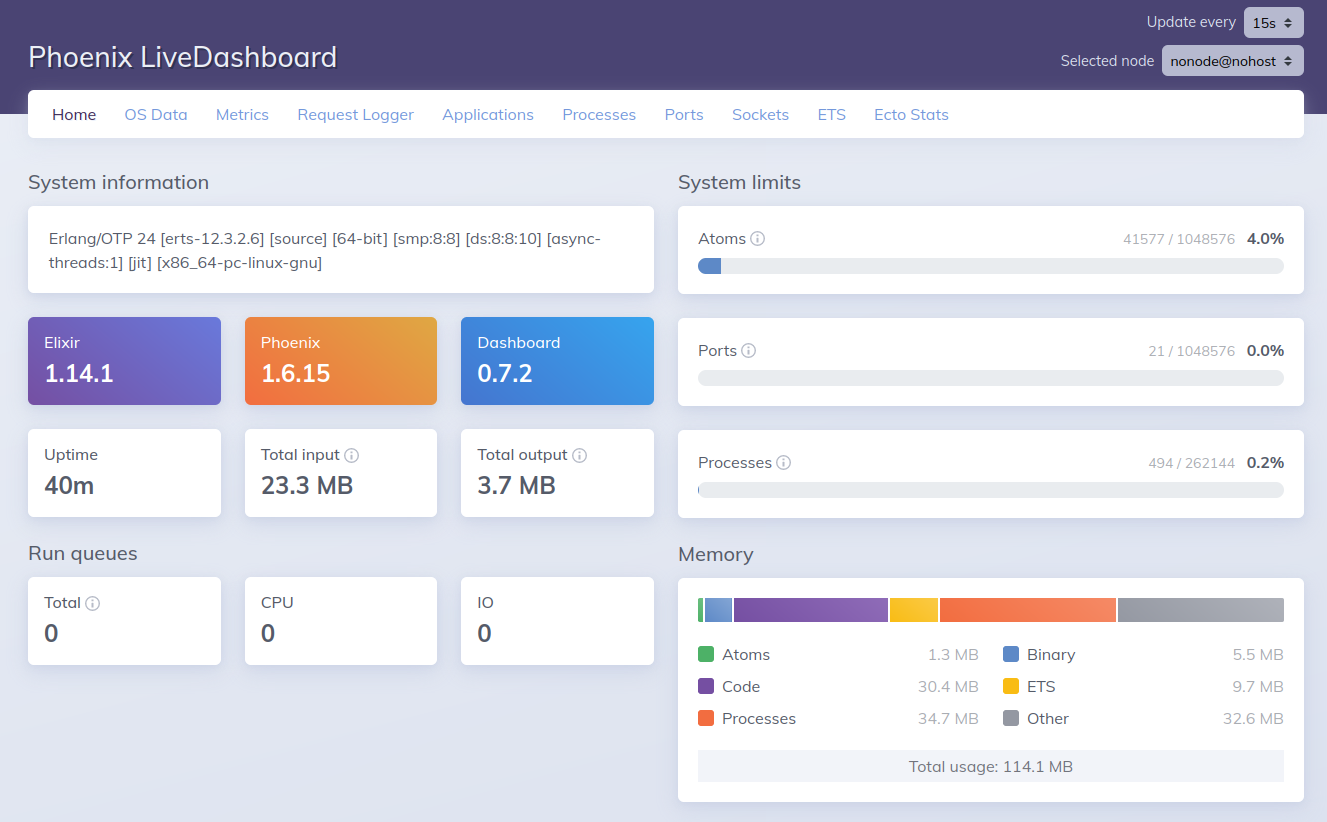If your Phoenix application enforces CSP rules, and you try to deploy the Phoenix LiveDashboard in production, you will probably get something like this:

In my case, inline CSS is not loaded because of the style-src CSP rule I had to enforce on the project:
style-src 'self';
This means that all unsafe inline CSS code is disabled by the browser. Unfortunately, the Phoenix LiveDashboard uses inline CSS, and that’s not something I can change.
Nonce basics
The LiveDashboard gives you a way to solve the problem with “Nonces”.
I didn’t know about them before, so here is what I learned: a Nonce is a random string designed to be used only once.
When the server sends the HTTP response back to the user browser, it generates for each request a random string, called a Nonce. For the sake of example, let’s say that the generated value is xyz.
The Nonce is put in the HTML response at two places:
- In the CSP headers.
For example, to allow safe inline CSS, the CSP header will contain:
style-src 'self' 'nonce-xyz';
- In the html, on the element that contains inlined CSS I want to allow.
<style nonce="xyz">#processes-total-progress{width:0.2%}</style>
When the browser receives such a response, it keeps only the inlined CSS matching the Nonce specified in the CSP headers, as it shows that the CSS code is genuine and has not been injected by someone else. More info here.
Phoenix LiveDashboard
Now that we know what we want to achieve, here is how to do it.
Nonce in the CSP
There are different ways to add CSP headers to your requests. On the project I work on, I have created a simple Plug like this:
defmodule MyApp.Plugs.CustomSecureBrowserHeaders do
def init(options), do: options
def call(conn, _opts) do
csp_headers = csp_headers(Application.fetch_env!(:my_app, :app_env))
conn
|> Phoenix.Controller.put_secure_browser_headers(csp_headers)
end
def csp_headers(app_env, nonce) do
csp_content =
case app_env do
:production ->
"""
style-src 'self';
"""
_ ->
nil
end
case csp_content do
nil -> %{}
csp_content -> %{"content-security-policy" => csp_content |> String.replace("\n", "")}
end
end
end
I use the put_secure_browser_headers function provided by Phoenix, with additional CSP headers. So I need to modify the Plug to create the random value and add it to the CSP content. I also register the generated Nonce value in a connection assign.
defmodule MyApp.Plugs.CustomSecureBrowserHeaders do
def init(options), do: options
defp generate_nonce(size \\ 10), do: size |> :crypto.strong_rand_bytes() |> Base.url_encode64(padding: false)
def call(conn, _opts) do
# a random string is generated
nonce = generate_nonce()
csp_headers = csp_headers(Application.fetch_env!(:my_app, :app_env), nonce)
conn
# the nonce is saved in the connection assigns
|> Plug.Conn.assign(:csp_nonce_value, nonce)
|> Phoenix.Controller.put_secure_browser_headers(csp_headers)
end
def csp_headers(app_env, nonce) do
csp_content =
case app_env do
:production ->
# the nonce is put in the CSP header content
"""
style-src 'self' 'nonce-#{nonce}';
"""
_ ->
nil
end
case csp_content do
nil -> %{}
csp_content -> %{"content-security-policy" => csp_content |> String.replace("\n", "")}
end
end
end
LiveDashboard
In the Plug above, the Nonce value is assigned to the key :csp_nonce_value. I need to pass the information to the Dashboard, and that’s it!
In your Router, use the csp_nonce_assign_key option:
live_dashboard("/phoenix-dashboard",csp_nonce_assign_key: :csp_nonce_value)
You should now be able to see a Nonce added to your server responses, both in the headers and in the HTML page. Every time you refresh the page, the Nonce value should change.

🎉
Edit
Following a question in the comments, if you want to use a different nonce for style, script and images, you need to make the following changes:
In the Plug code, create 3 assigns containing the 3 different values.
def call(conn, _opts) do
# a random string is generated
nonce_1 = generate_nonce()
nonce_2 = generate_nonce()
nonce_3 = generate_nonce()
csp_headers = csp_headers(Application.fetch_env!(:my_app, :app_env), nonce_1, nonce_2, nonce_3)
conn
# the nonce is saved in the connection assigns
|> Plug.Conn.assign(:img_src_nonce, nonce_1)
|> Plug.Conn.assign(:img_style_nonce, nonce_2)
|> Plug.Conn.assign(:img_script_nonce, nonce_3)
|> Phoenix.Controller.put_secure_browser_headers(csp_headers)
end
In the router file, you pass the name of those assigns as options, not the nonce value itself.
live_dashboard("/phoenix-dashboard",
metrics: Transport.PhoenixDashboardTelemetry,
csp_nonce_assign_key: %{
img: :img_src_nonce,
style: :img_style_nonce,
script: :img_script_nonce,
})
The doc is not very clear about what you should pass, but it says you need pass a %{optional(:img) => atom(), optional(:script) => atom(), optional(:style) => atom()}. It expects an atom, not a string!